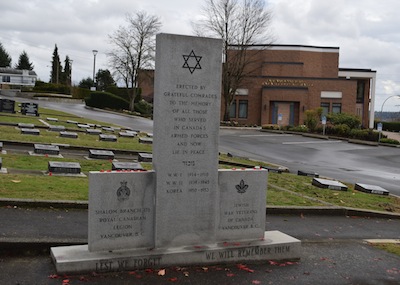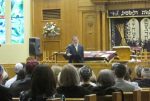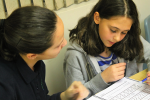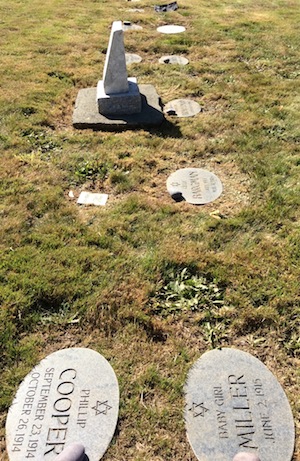Howard Jampolsky tells the story of how community members came together to support a family after the death of their husband, father. (photo from Schara Tzedeck Cemetery Board)
Taking care of the deceased is known as a chesed shel emet, or “the truest act of kindness.” The Schara Tzedeck Cemetery Board and Chevra Kadisha practise this every day.
We take care of our community’s deceased, and help their families from the time of death through the funeral service. Of course, because we have financial obligations like any other organization, we charge for our services. However, every family is charged the same price for burial plots and funeral services, and we only offer a traditional burial with all the proper rites. We treat every deceased person and their families equitably.
This practice varies only if a family is not in a financial position to pay the full costs. Sometimes, families simply need an extended period to pay for the funeral – for example, when funds are only available from the estate. Sometimes, families cannot pay the full amount, as this would cause a significant hardship. And then, there are times when a family is simply not able to pay anything at all. In all of these cases, we provide the same services as we provide everybody: it is our core belief and mission to provide a full and proper Jewish funeral according to all the customs and laws.
We carry out about 125 funerals each year and, while each is unique, there are some that truly stand out. This chronicles one such story.
On a cold and rainy day in October, I received a call from Rabbi Hillel Brody, who serves as the religious leader of the Louis Brier Home and Hospital. He told me there was a resident who was dying and his wife, who we will call “Margaret” (names have been changed in this story to protect privacy), was worried for a variety of reasons. Margaret and her husband “Shmuel” had moved to Vancouver about 10 years earlier and, because of Shmuel’s failing health, much of their time was spent visiting doctors and caring for him. They tried to connect with the community, but were unable and, earlier that year, Shmuel was moved into the Louis Brier. Margaret began to find some connection to people just by being in the more active setting of the home, but, still, her focus was almost entirely on caring for Shmuel. This devotion to her husband was admirable, but it came with a price – they did not have any close friends.
Margaret had no idea where to begin when it came to planning for Shmuel’s burial. To make matters worse, Margaret and Shmuel did not have the money to pay for a funeral or a burial plot. Rabbi Brody assured Margaret that the Schara Tzedeck Cemetery Board and Chevra Kadisha would take care of things. He told me that the only family was a daughter, who lived in Toronto, and he told me that she had decided to visit a few weeks earlier to see her father and say her goodbyes while he was still alive. As she could only make one trip, she had made this difficult choice, and was not going to be able to come for the funeral.
When Shmuel passed away, I called Margaret and arranged to meet her at her apartment to go over the details and get all the necessary paperwork signed. Margaret and Shmuel had been together for almost 50 years, and life had always been hard. They were both Holocaust survivors, both were born in Hungary. Shmuel had been held by the Nazis as a very young boy of less than 10 years old and, because of the conditions that he and other Jews were under, he became very ill from malnutrition and as a result of Nazi torture. He was fortunate to not have been murdered by the Nazis, as so many were, but though he survived and was rescued, he never truly recovered.
Margaret and I completed the paperwork required for registering Shmuel’s death, and talked about the funeral. She was shocked and humbled when I told her that we would provide Shmuel with a full and proper Jewish funeral and she would not have to pay anything. Her tears flowed again, but this time from relief.
Margaret told me she did not even know how she would be able to get to the cemetery. She had sold her car some years earlier, and would take the bus every day to be with Shmuel at Louis Brier. I told her that Rabbi Brody had offered to drive her to the cemetery. Again, she was surprised and grateful.
At this point, the funeral would be one of the smallest I had ever attended. It was looking like Margaret, Rabbi Brody and I would be the only people there. I knew that Margaret needed more help. The thought of her being dropped off at her small apartment to be alone after burying her husband was upsetting. She needed more support, and I asked Margaret if it would be OK if we purchased an airline ticket for her daughter, “Monica,” to come to Vancouver to be here for a few days, including for the funeral.
Margaret was at first confused by the question. I’m not sure she even comprehended what I was saying. But Monica accepted our offer and, later that day, an airline ticket was purchased for her.
With Monica in town, Margaret would be able to get to the cemetery, as Monica’s good friend, “Bill,” had agreed to drive them. Two more people would be there to help bury Shmuel.
I went home that evening feeling both exhausted and energized. I had worked hard that day to make sure everything would work for Margaret, but the weight of the day was offset by the buoyancy of the good deeds that were also done. Margaret was going to get through this a little easier now, and it felt good.
On arrival the next morning at shul, I saw Rabbi Brody. He told me he was inspired by what we had offered Margaret, and mentioned that he had advised Congregation Schara Tzedeck’s Rabbi Andrew Rosenblatt that the funeral was taking place the following morning. He said he had asked Rabbi Rosenblatt to announce the funeral to his congregation and, if anyone could attend, they should contact me.
I approached a congregant who is a wills and estates lawyer, and he offered to provide Margaret with legal help in dealing with her husband’s affairs, for no charge.
At the end of the service, another congregant approached me and asked me to contact Omnitsky Kosher and order food for the family to be sent over following the funeral, with the bill directed to her.
Neither of these people had ever heard of Margaret, or Shmuel, or Monica. They just were part of a community that was beginning to rally around a fellow community member to give her the support we would all need in such a situation.
The weather was forecast to be very windy and wet for the Sunday funeral, but we were lucky that it was still dry. Monica had told me she let a few people know about the funeral, and that they may come, so I was not surprised when I saw two people walking into the small cemetery. As they approached, I asked them if they were friends of Monica. They told me they did not know anyone by the name of Monica, but had heard there was funeral this morning for a Holocaust survivor, and that there would be only a few people here, and they wanted to come to support the family.
A few moments later, another car drove up – a man with his two sons arrived for “a funeral they had heard about.” Car after car arrived. More and more people gathered, some who had driven almost an hour to lend support to a total stranger and to participate in the mitzvah of laying Shmuel to rest.
When the funeral started at 11 a.m., there were close to 30 people there – none of whom had ever met Shmuel, Margaret or Monica.
The beauty of a chesed shel emet is that everyone gains. I know that everyone at the funeral, and everyone who helped in some way or another, benefited from this experience. But, most of all, Margaret benefited and will continue to benefit from a community that supported her in her darkest hour, and will continue to help her.
Margaret will mourn and grieve. She does not know how she will be able to live on without Shmuel, and cannot imagine ever recovering from this physical and emotional blow.
But she will.
Howard Jampolsky is executive director of Schara Tzedeck Cemetery Board.












